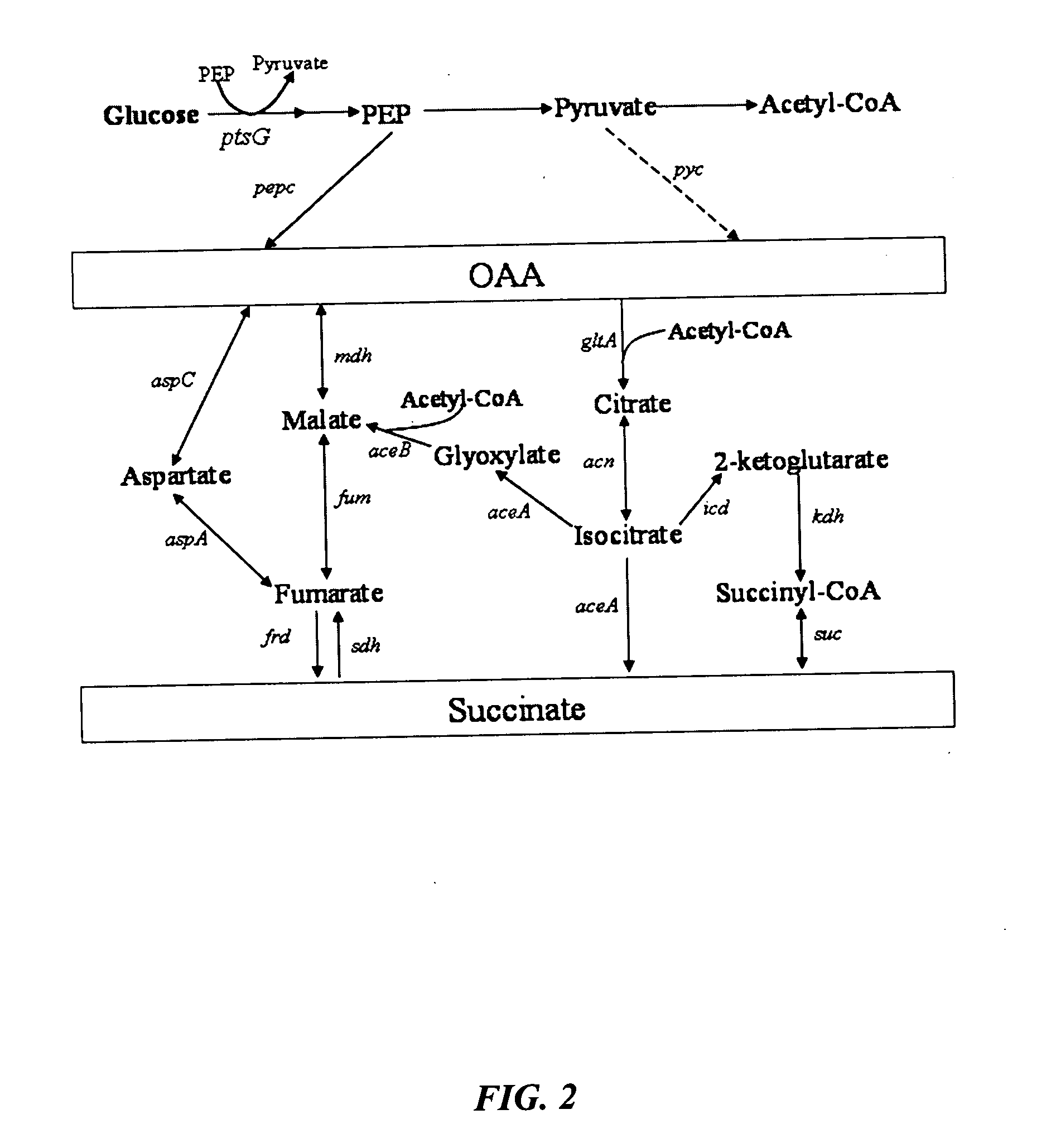Aerobic succinate production in bacteria
a technology of aerobic succinate and bacteria, applied in the field of aerobic succinate production in bacteria, can solve the problems of poor biomass generation, hampered anaerobic fermentation, and high cost of petrochemical processes, and achieve the effect of improving carboxylic acid production and increasing succinate yield
- Summary
- Abstract
- Description
- Claims
- Application Information
AI Technical Summary
Benefits of technology
Problems solved by technology
Method used
Image
Examples
example 1
Developing Aerobic Succinate Production Strains
[0038]FIGS. 8 and 9 show succinate production and yield from cultures of each mutant strain and the parental strain. In the mutant strain HL2k, with only sdh inactivated, succinate accumulated during culture. Succinate accumulation was not possible in the wildtype (GJT001) as shown by zero succinate production (FIG. 8a). Inactivation of the two acetate pathways, poxB and ackA-pta, further increased succinate production and yield as shown by mutant strain HL267k. Next, as dictated by the design strategy, icd was inactivated creating mutant strain HL2671k. When the icd was inactivated, succinate production decreased as expected since the cell probably could no longer use the oxidative arm of the TCA cycle to produce succinate. The amount of succinate produced by HL2671k could be due to the glyoxylate bypass being partially active. The molar succinate yield of HL2671k increased significantly but this was accompanied by a much lower glucos...
example 2
Succinate Production Through Glyoxylate Shunt
[0039] Mutant strains HL51276k and HL2765k were generated which removed acetate production through acetate kinase-phosphotransacetylase (ackA-pta) and pyruvate oxidase (poxB). Succinate dehydrogenase (sdh) was deleted to prevent the formation of downstream Krebs cycle intermediates. Isocitrate lyase (aceA) repression was removed to allow constitutive activation of the aceBAK operon producing excessive amount of isocitrate lyase and malate synthase. Additionally, isocitrate dehydrogenase was removed from HL51276k to prevent the upstream production of 2-ketoglutarate. Results (Table 3) showed that strain HL2765k had a higher succinate production than HL51276k. At approximately 48 hours, the succinate concentration in the HL2765k culture was 40 mM compared to 31 mM succinate produced by the HL51276k culture (FIG. 3a). Succinate molar yields at the highest concentration produced were 0.67 for HL2765k and 0.65 for HL51276k. HL2765k also had 6...
example 3
Removing Glucose Transport
[0041] Inactivation glucose phosphotransferase system (PTSG) was studied in HL2765k and HL51276k by knocking out ptsG to form HL27659k and HL512769k (hexamutant strain of E. coli). Strains HL27659k and HL512769k were grown aerobically under batch reactor conditions previously described. At approximately 48 hours, HL27659k produced 49 mM succinate over 40 mM produced by HL2765k and HL512769k produced 44 mM succinate over 31 mM produced by HL51276k (FIG. 4a). PTSG inactivation increased molar yield from 0.67 for HL2765k to 0.78 for HL27659k and from 0.65 for HL51276k to 0.87 for HL512769k. Volumetric succinate productivity was increased 38% and specific productivity 22% for HL27659k over HL2765k. HL512769k had 51% higher succinate volumetric productivity and 48% higher specific productivity than HL51276k. Inactivation of PTSG caused a decrease in cell growth due to slower glucose consumption. The biomass generation rate of strain HL2765k was 0.60 g / l-hr comp...
PUM
| Property | Measurement | Unit |
|---|---|---|
| Dimensionless property | aaaaa | aaaaa |
| Dimensionless property | aaaaa | aaaaa |
| Substance count | aaaaa | aaaaa |
Abstract
Description
Claims
Application Information
 Login to View More
Login to View More - R&D
- Intellectual Property
- Life Sciences
- Materials
- Tech Scout
- Unparalleled Data Quality
- Higher Quality Content
- 60% Fewer Hallucinations
Browse by: Latest US Patents, China's latest patents, Technical Efficacy Thesaurus, Application Domain, Technology Topic, Popular Technical Reports.
© 2025 PatSnap. All rights reserved.Legal|Privacy policy|Modern Slavery Act Transparency Statement|Sitemap|About US| Contact US: help@patsnap.com



